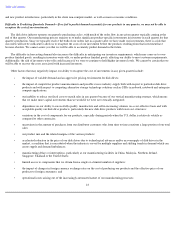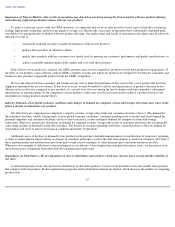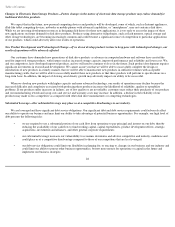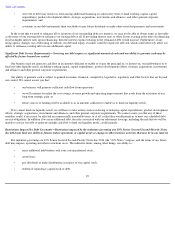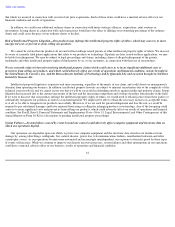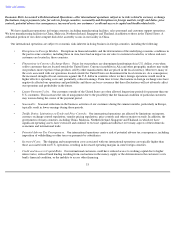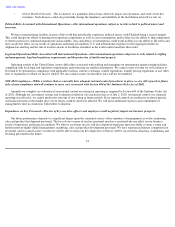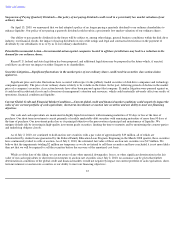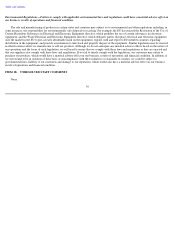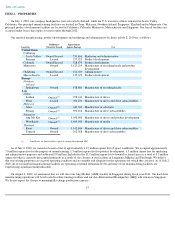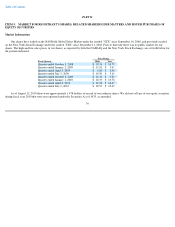Seagate 2009 Annual Report Download - page 34
Download and view the complete annual report
Please find page 34 of the 2009 Seagate annual report below. You can navigate through the pages in the report by either clicking on the pages listed below, or by using the keyword search tool below to find specific information within the annual report.
Table of Contents
that which we incurred in connection with several of our prior acquisitions. Each of these items could have a material adverse effect on our
financial condition and results of operations.
In addition, we could issue additional ordinary shares in connection with future strategic alliances, acquisitions, joint ventures or
investments. Issuing shares in connection with such transactions would have the effect of diluting your ownership percentage of the ordinary
shares and could cause the price of our ordinary shares to decline.
Risk of Intellectual Property Litigation
—Our products may infringe the intellectual property rights of others, which may cause us to incur
unexpected costs or prevent us from selling our products.
We cannot be certain that our products do not and will not infringe issued patents or other intellectual property rights of others. We may not
be aware of currently filed patent applications that relate to our products or technology. If patents are later issued on these applications, we may
be liable for infringement. We may be subject to legal proceedings and claims, including claims of alleged infringement of the patents,
trademarks and other intellectual property rights of third parties by us, or our customers, in connection with their use of our products.
We are currently subject to lawsuits involving intellectual property claims which could cause us to incur significant additional costs or
prevent us from selling our products, and which could adversely affect our results of operations and financial condition: actions brought in
the United States by Convolve, Inc. and the Massachusetts Institute of Technology and by Qimonda AG; and an action brought in Northern
Ireland by Siemens AG.
Intellectual property litigation is expensive and time-consuming, regardless of the merits of any claim, and could divert our management's
attention from operating our business. In addition, intellectual property lawsuits are subject to inherent uncertainties due to the complexity of the
technical issues involved, and we cannot assure you that we will be successful in defending ourselves against intellectual property claims. Patent
litigation has increased due to the current uncertainty of the law and the increasing competition and overlap of product functionality in the field.
If we were to discover that our products infringe the intellectual property rights of others, we would need to obtain licenses from these parties or
substantially reengineer our products in order to avoid infringement. We might not be able to obtain the necessary licenses on acceptable terms,
or at all, or be able to reengineer our products successfully. Moreover, if we are sued for patent infringement and lose the suit, we could be
required to pay substantial damages and/or be enjoined from using or selling the infringing products or technology. Any of the foregoing could
cause us to incur significant costs and prevent us from selling our products, which could adversely affect our results of operations and financial
condition. See Part II, Item 8. Financial Statements and Supplementary Data—Note 13, Legal, Environmental, and Other Contingencies of this
Annual Report on Form 10-K for a description of pending intellectual property proceedings.
System Failures
—System failures caused by events beyond our control could adversely affect computer equipment and electronic data on
which our operations depend.
Our operations are dependent upon our ability to protect our computer equipment and the electronic data stored in our databases from
damage by, among other things, earthquake, fire, natural disaster, power loss, telecommunications failures, unauthorized intrusion and other
catastrophic events. As our operations become more automated and increasingly interdependent, our exposure to the risks posed by these types
of events will increase. While we continue to improve our disaster recovery processes, system failures and other interruptions in our operations
could have a material adverse effect on our business, results of operations and financial condition.
32



